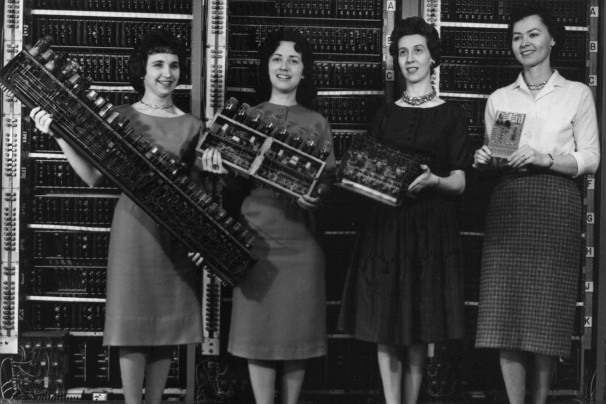Women in Data
Women in data and technology are no longer outliers or anomalies; they are entering the mainstream and excelling where technical skills, advanced education, and no small amount of personal tenacity and brilliance are the minimum requirements.
 From Left to right: Patsy Simmers, Mrs. Gail Taylor, Mrs. Milly Beck and Mrs. Norma Stec, holding the ENIAC and newer versions of computer boards. (source: U.S. Army Photo (Wikipedia))
From Left to right: Patsy Simmers, Mrs. Gail Taylor, Mrs. Milly Beck and Mrs. Norma Stec, holding the ENIAC and newer versions of computer boards. (source: U.S. Army Photo (Wikipedia))
Introduction
Women in data and technology are no longer outliers or anomalies; they are entering the mainstream and excelling where technical skills, advanced education, and no small amount of personal tenacity and brilliance are the minimum requirements. That said, women are still an underrepresented minority in the disciplines of science, technology, engineering, and math, known by the acronym STEM.
To investigate and understand how and why some women do extremely well, we interviewed 15 women in data to learn what got them to their current level of success, exactly what motivated them to get there, and their views about opportunities for women in tech. We were very keen on hearing their recommendations about what needs to get “fixed” to close the tech gender gap for others.
We think you will find the stories shared during these interviews both interesting and inspiring. They reveal insights that will widen the path for other women analysts, engineers, mathematicians, and data scientists. These insights include:
- An update on the expanding role of the contemporary data scientist
- New attitudes toward women in data among Millennials
- Benefits of the data and STEM fields as a career choice for women
- Much needed and increasingly sought after remedies for closing the gender gap
Wondering what’s new? The gender gap in tech is not news, but here’s what is: it’s shrinking. The underrepresentation of women in tech has garnered tremendous attention and support of late to the point where the continued existence of the numbers disparity has fostered a nation-wide movement to bring more women into technical fields. Starting with the feeder pipeline of education (from kindergarten to university) and continuing through to diversity issues in and beyond the workplace, bridging the gender gap in STEM and tech is now a nation-wide crusade and a very hot topic.
The groundswell of attention comes from every possible sector: public and private companies, national and local governments, associations, educators, parents, teachers, scientific organizations, media publicity, and trade groups. Emphasis is on correcting a range of loss and leakage issues that occur at multiple points along the career continuum. Extending from the type of coursework offered in schools, factors that discourage women from selecting and staying with tech include cultural bias, behavioral psychology, and gender stereotypes. Now through increased publicity, there is a definite assault on the gender gap issue.
Our data practitioners confirm that dispelling myths of women’s inability to do well in math and tech is only a small part of the battle. Other challenges center on advancing the idea that gender diversity fuels creativity, innovation, and economic growth. Much work needs to be done to publicize these truths and change the prevailing mindset.
Because women represent over 55% of the workforce, it is striking that fewer than 25% of jobs in technical and computing fields are held by women. When 58% of bachelor’s degrees are being awarded to women, why are only 18% of computer science degrees going to women? Silicon Valley companies are leading the way in looking into these disparities and opening up advancement to better paying, higher prestige, leadership positions to their female employees. These jobs are also exciting and satisfying, and contribute handsomely to the bottom line.
Perhaps because big data has created a tsunami of new challenges and opportunities, or perhaps because of the well-publicized need to fill over 1.4 million new jobs in computer science by 2020 (jobs that will largely go unfilled), or perhaps because of a national sense of not wanting to fall behind on the world stage, closing the gender gap in tech is finally making it to the national priority list.
Our interviews with practitioners in data and STEM reveal that they are themselves the solution and model for the much needed changes that will help close the gender gap in tech.
